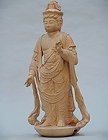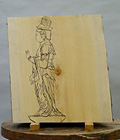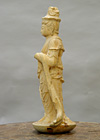Japanese Gallery (Honkan) Room 20
June 15, 2010 (Tue) - October 3, 2010 (Sun)
This display follows a four-step process to create a model of Sho Kannon, an Important Cultural Property from Daigoji Temple in Kyoto.
The original Sho Kannon is a minutely carved sculpture of fragrant wood. The robe, both arms, and the lotus blossom pedestal are all carved out of a single piece of Japanese nutmeg, which is known as kaya. The nutmeg tree is known for being fine-grained, hard, and tough. It is also known as a fragrant wood, so it was used as a substitute for sandalwood, which had to be imported from China. Just as in the original, the models were made out of nutmeg wood, and the trunk cores were aligned and positioned in the same way as the original. The statue was made after attempting to reconstruct techniques used at the time. This was accomplished by using the same types of tools that were available during the first half of the Heian period (794-1192).





